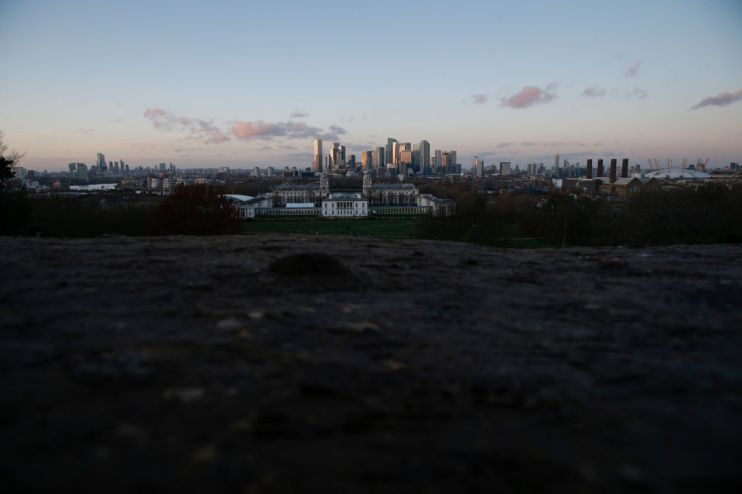Recession dials flash red on UK economic dashboard

The dials are flashing red on the dashboard of the health of the British economy.
Just a few months ago, UK growth prospects were reasonably good. The Covid-19 bounce back was set to continue this year, building on the country notching the biggest expansion in the G7 in 2021 (albeit due to the UK suffering a worse hit from the pandemic).
The International Monetary Fund said in January the economy would grow 4.7 per cent and 2.3 per cent this year and next.
Although still weak, the Bank of England thought in February expansion will come in at 1.25 per cent next year.
You’d be forgiven for thinking those projections seemed a long, long time ago after a string of some of the glummest forecasts since the financial crisis have trickled out over the week or so.
A much larger than expected inflation surge caused by an imported energy price shock has cast a long shadow over top forecasters’ bets on the economy, none more so than the Bank.
There is real risk the UK will tip into recession soon, Threadneedle Street warned last week, culminating in the economy shrinking 0.25 per cent in 2023. Worryingly, growth barely gets its head above 0.6 per cent over the next three years.
Add to the mix the National Institute of Economic and Social Research (NIESR) now forecasting a technical recession – two consecutive quarters of contraction – will hit this year.
The IMF has also downgraded their view on the UK, as has the Office for Budget Responsibility.
These glum predictions all have one thing in common that has led their authors to draw similar conclusions.
A much higher and longer than expected inflation crunch, coupled with weak wage growth, will erode living standards at one of the fastest paces in modern history this year.
In response, households will cut spending on non-essentials due to their budgets being suffocated by energy and food bills.
Weak consumption will weigh on growth.
But, the velocity of the swing in consumer behaviour will ultimately define how deep the UK’s recession is.
Demand may be shielded from the cost of living grip by Brits raiding their estimated £200bn of savings accumulated during the pandemic.
The NIESR “expect[s] private consumption growth of 4.7 per cent this year” on a rundown of these savings helping to “smooth spending patterns and ensure that consumption falls by less than income”.
Banks are also keen to lend to consumers after they pulled back from risky segments of the market during the pandemic, which will help bridge income gaps. Interest rates are still low by historical standards, despite the Bank lifting them to a 13-year high of one per cent, affording people greater room to pay back debt.
However, data suggests Brits may be unwilling to tap their savings war chests. Consumer confidence plunged to its second lowest level on record last month, beaten only by the immediate aftermath of the financial crisis, according to GfK.
People may leave their rainy day funds untouched to protect themselves from future economic shocks. Bank of England data shows savings jumped £6bn between February and March.
A large proportion of these savings are concentrated among wealthier households, who tend to spend less of each additional pound they earn compared to lower income households.
Around 1.5m households’ food and energy bills will outstrip their food and energy bills this year, the NIESR estimates, meaning this group will spend less in the services economy, the UK’s growth engine.
Richer households will have to take up the role of driving spending, something they are arguably more adverse to.
The biggest downside risk to the economy suffering a deeper recession is if inflation smashes even Threadneedle Street’s bleakest predictions of a double-digit peak in October.
This may happen. A further escalation and a prolongation in the Russia-Ukraine war will suck energy and food supplies out of the market, leaving prices elevated for much longer.
China’s zero-Covid policy will keep supply chains snarled up.
If the UK jobs does not loosen, upward wage pressures are likely to persist, strengthening incentives for firms to keep raising prices.
The actions of the Bank of England’s US counterpart, the Federal Reserve, could put the pound in a vice, making it more expensive to import goods and services (something the UK already does in spades).
The Fed is widely expected to waive through more 50 basis point rate hikes this year, making it more attractive to buy dollar-denominated assets, weakening the pound.
Threadneedle Street’s own tightening cycle will deal a blow to the UK economy by cooling activity. In fact, the Bank’s recession warning is conditioned on rates reaching 2.5 per cent by the middle of next year.
If rates stay at one per cent, the Bank thinks Britain will avoid a recession, suggesting it was pushing back against market expectations.
Monetary authorities are not equipped to deal with economic shocks generated by supply shocks, such as the one we’re seeing play out now. Instead, central banks are designed to balance demand to manage inflation.
The Bank’s “too little too late” rate hikes, as the NIESR put it, do however have something to answer for.
But, its role in cushioning the pressure on the around 250,000 UK households that will fall in extreme poverty this year is limited.
Fiscal policy makers now need to take on more of the economic stress the UK will bear this year.